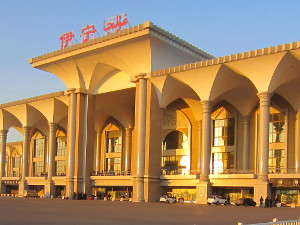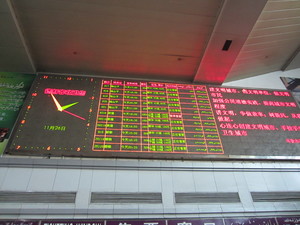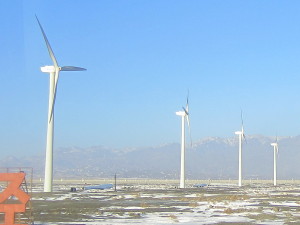I'm lagging a bit behind with blogging, so I'm trying to quickly recap the recent days of my journey in China. I already mentioned that I arrived in Yining, which is a town near the border to Kazakhstan. I was a bit surprised, because I more or less expected a small town, but I found out that Yining isn't that small. It has 430.000 inhabitants (at least Wikipedia says so, maybe it's outdated) and the distances sometimes were quite huge and I did a lot of walking there. The train station was a bit outside and walking there I passed a number of construction sites for new residential area. I first thought I found one of the "ghost towns" many western media lately reported about, a clean and new looking residential area. But a closer look revealed that it was probably just not finished - inside the buildings construction work was still going.
I took the train from Yining to Urumqi. My original plan was to move along quite fast and directly take the next train to Xi'an. But that didn't really work. I had to find out that all train tickets for the upcoming days to every location east of Urumqi were sold out. This was kind of a déjà vu. Last time I was in China I had the plan to travel this way in the other direction - and no tickets were available. Reading local news, this situation might improve 2014, when a
new highspeed train line opens between Urumqi and Lanzhou. I didn't want to wait that long though.
However, this time I knew that there are alternatives - by taking the bus. I took a bus to the town Dunhuang, which is about 1,000 kilometers east of Urumqi.
Finding out the bus times in Urumqi was a bit tricky. At the bus station, there was a screen with scrolling departure times - but only in Chinese. While I am in theory able to recognize Chinese characters, this was much too fast for me (and there were a lot of buses). No paper or otherwise static timetable was available. My solution was to do many photographs of the timetable. That worked and afterwards I bought the ticket. I usually do this by writing down the time, date, the start and destination - usually that works quite well when language communication is limited due to language barriers. I took a bus the next day starting at 4 p. m., which arrived in Dunhuang at around 8 a. m., so it took roughly 16 hours.
The bus trip through the Xinjiang desert passed a lot of wind turbines. While China is often portrayed as the environmental bad guy, one shouldn't fail to recognize that it's also the world leader in building renewable energies. However, the many Xinjiang wind turbine fields also told the other not so green side of the Chinese renewable boom: Many of the turbines were just standing still. The most likely reason: China is building up wind power faster than it's caring for grid integration. I'm used to that look in Germany - wind power there is also often downregulated, because grid integration is not keeping up with the installation of new wind energy. But it was quite obvious that this problem is far bigger here in China's desert.
In Dunhuang I spend three nights. Dunhuang is not on the Urumqi-Lanzhou train line, so the scarce ticket situation there doesn't affect me here. But still, I didn't get a ticket for the train I wanted and had to stay one day longer. After having traveled through several huge cities, staying here for some time was okay and I did things a bit slower. Dunhuang is famous for the Mogao caves, which are a famous tourist attraction with buddhist statues and wall paintings. I'm usually not the person who has to see every tourist attraction on the way, but as I had more time than expected, I went there.
Tomorrow I'll take the train to Lanzhou.
 Pictures from Yining
Pictures from Dunhuang
Pictures from wind power turbines in the Xinjiang province
Pictures from Lanzhou
Pictures from Yining
Pictures from Dunhuang
Pictures from wind power turbines in the Xinjiang province
Pictures from Lanzhou


